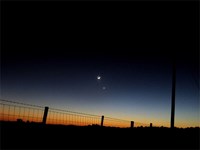 |
WAXING CRESCENT MOON AND VENUS
"The Old Moon in the New Moon's Arms." Here a waxing crescent moon, 1.8 days old, and Venus shine in evening twilight (2007 January 20). Location: South of Alachua, Florida about 100 ft. west of NW 143rd St. on NW 94th Ave. Even a simple point and shoot camera can do sky photos. Click for larger version including annotation. Photo Details: Canon Powershot A710, FL = 46 mm, 2.5s at f/5.0, 1.6s at f/4.8 (inset). 35mm equivalent focal lengths given. ISO Equivalent 100.
|
|
 |
THREESOME: MOON, VENUS AND MERCURY
A Young Moon with Brilliant Venus and Mercury in the Evening Western Sky. Many never see Mercury but here it is with the night's brightest planet, Venus, and a beautiful, thin waxing crescent moon (2010 April 15, 8:40 p.m. EDT). Moon is but 1.5d old (illumination 2.6%), elongation 18° from Sun. Mercury is only 1.3° to lower left of Moon at an altitude of only 6.3° and a magnitude of +1.5. (Venus magnitude is -3.9.) Hubble images are great but the thrill of astronomy is seeing the heavens for yourself. Photo Details: Canon DSLR EOS 5D II, fixed mount. Canon 28-135mm, f/3.5-5.6 IS USM Lens at 135mm, Exp. 6s @ f/5.6 (ISO Equiv. 800). Location: Gainesville, Florida.
|
|
 |
MARS AT CLOSEST APPROACH, 2010
Brilliant Orangey Mars. Mars (mag. -1.3) shone in the eastern sky nearly as bright as Sirius (mag. -1.5) about 50 degrees toward west. However, Mars shines with an orangey color in contrast to whitish Sirius. This was the night of closest approach to Earth in 2010 (0.66 AU). Still, this was not an especially favorable opposition although Mars was well placed for Northern Hemisphere observers with a large northern declination of +22 degrees. So, the very small disk of Mars (14.1 arc sec) required large apertures and long focal lengths to show detail. Here, the effective focal length of the 127 mm aperture telescope (2640 mm) used for this photo is really too small to show detail. However, the Martian polar cap is clearly seen in this enlarged image, extremely cropped from the original frame. (Image is only about 0.5% of the original frame height!) In 2018 Mars will have a favorable opposition (July 27, distance 0.39 AU, disk 24.3 arc sec, mag. -2.8) but the planet will be poorly placed for Northern Hemisphere observers due to its large southern declination (-26 degrees). Photo Date: 2010 January 27, 10:33 p m. EST (January 28, 03:33 UT). Photo Details: Tele Vue 127 mm, f/5.2 APO refractor with Tele Vue 4x Powermate for an effective f/21 focal ratio. Canon DSLR EOS 5D II. Exp. 1/180s (ISO Equiv. 800). Location: Gainesville, Florida.
|
|
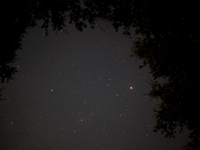
Mars Through Tree Canopy
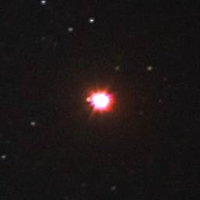
Enlargement of Above
|
MARS AT CLOSEST APPROACH, 2016
Mars Through the Canopy. During late May 2016 Earth approached Mars closer than these two planets had been in more than ten years. The brilliancy and color of Mars made a fine sight for naked eyes during evening skies in Florida. Here Mars shines through a canopy of trees in a photo taken with only a "standard" camera lens of 50 mm focal length. Nevertheless, the picture shows more than at first meets the eye. (Read on.)
First, click picture to enlarge or see a labeled version to help identify Mars and a few neighboring objects.
But, this photo shows more than just Mars and obvious neighboring celestial objects. Look very, very closely just to the left of Mars. Here is a faint star just touching the image of Mars (5.6 arc min away)! See this highly enlarged image (or enlarged labeled version). Luckily this photograph was accidentally taken just at the right time. If taken a few hours earlier, the star would have blended with Mars. If taken a few hours later the star would have been well separated from Mars.
This faint looking star (mag. +7.6, designated HD141466) appears fainter than Mars (mag. -2.0) by more than 7,200 times! Why? This star is actually much brighter and larger than our Sun but is about 660 years away! Finally, HD141466 is cooler than the Sun so its color is remarkably similar to Mars — orangy! Photo Date: 2016 May 27, 1:14 a m. EDT (05:14 UT). Photo Details: Canon EOS 5D II on fixed tripod mount. Exposure 8 sec. at f/2, ISO 1600 with 50 mm, f/1.8 lens. Location: Gainesville, Florida. See article about these photographs. (PDF — opens in new window.)
|
|
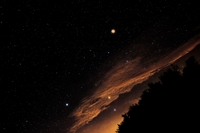 |
MEMORIAL DAY MARS — 2016
A Colorful Display. The planet Mars reached its closest distance to Earth Memorial Day USA, 2016 May 30. Appropriately, this planet, also named for the Roman god of war, had its close approach on a day that we also remember those who died while serving in our military. This photo, like the one above, again shows a wide-field image of Mars (top center) and its surrounding but now better shows the planet's brilliance and color. See also Labeled Version. Photo Date: 2016 May 29, 11:01 p.m. EDT (May 30, 03:01 UT). Photo Details: Canon EOS 5D II on equatorial driven mount. Exposure 8 sec. at f/2, ISO 1600 with 50 mm, f/1.8 lens. Location: Gainesville, Florida. See article about these photographs. (PDF — opens in new window.)
|
|
 |
TWO DEGREES OF SEPARATION: JUPITER AND MERCURY
Jupiter and Mercury Shine Above Western Horizon Clouds. Elusive Mercury is often hard to spot being near the Sun but it can be quite bright. Here Mercury shines only two degrees to the right of Jupiter in the evening western sky above the Easton Newberry Sports Complex north of Newberry, Florida (2011 March 15). The Alachua Astronomy Club holds star parties here at its Newberry Star Park east of the main buildings. Location: Easton Newberry Sports Complex, Newberry, Florida. Photo Details: Canon DSLR EOS 5D II, fixed mount. Canon 100-400mm, f/4.5-5.6L IS USM Lens at 190mm, Exp. 2s @ f/5.6 (ISO Equiv. 800).
|
|
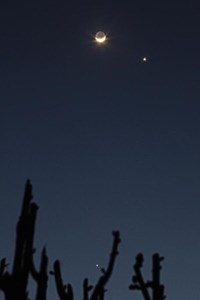 |
MOON WITH EARTHSHINE, VENUS AND JUPITER
Earthshine Illuminates Night side of Moon with Brilliant Venus and Jupiter. Venus appears to lower right of Moon in evening, western sky; Jupiter is seen at bottom just above plant branches (2012 March 27, 00:21 UT). Location: Gainesville, Florida. Photo Details: Canon DSLR EOS 5D II, fixed mount. Canon 75-300mm, f/4.5-5.6 IS USM Lens at 135mm, Exp. 5s @ f/16 (ISO Equiv. 3200).
|
|
 |
OLD DAWN MOON WITH EARTHSHINE
Earthshine On Old Waning Moon. Only early risers see thin waning crescent Moons. Here a 27.5 day old Moon (4.7 Percent Illumination) rises before the Sun on 2012 March 20, 6:47 a.m. EDT. Earthshine on the Moon helped make this a pretty scene in the eastern dawn sky. Photo Details: Canon DSLR EOS 5D II, fixed mount. Canon 28-135mm, f/3.5-5.6 IS USM Lens at 135mm, Exp. 1.3s @ f/5.6 (ISO Equiv. 2000). Location: Gainesville, Florida.
|
|
 |
DAWN SKY WITH PLANETS AND STAR CLUSTERS
A Dawn Sky with Planets Greets Early Morning Risers. Jupiter shines above bright Venus in the eastern sky on 2012 July 10 at 5:02 a.m. EDT (09:02 UT). In Taurus (the "Bull"), Aldebaran is to lower right, Hyades Cluster to upper right, Pleiades Cluster is near top. Click picture to enlarge but also see large annotated version. Photo Details: Canon DSLR EOS 5D II, fixed mount. Canon 28-135mm, f/3.5-5.6 IS USM Lens at 65mm, Exp. 10s @ f/6.7 (ISO Equiv. 6400). Location: Gainesville, Florida.
|
|
 |
DAWN SKY NOW WITH OLD MOON, PLANETS AND STAR CLUSTERS
Waning Gibbous Moon Now Enters Dawn Sky. A view five days later than previous picture above now shows the early morning sky of 2012 July 15 with a waning crescent moon (25.75 days old). Venus is to lower right of Moon and Jupiter at upper right. Aldebaran, brightest star in Taurus appears to upper right of Venus with the Hyades Star Cluster to right and Pleiades Star Cluster near top. Also see enlarged annotated version. Photo taken at 5:02 a.m. EDT (09:02 UT). Photo Details. Canon 28-135mm, f/3.5-5.6 IS USM Lens at 65mm, Exp. 8s @ f/6.7 (ISO Equiv. 6400). Location: Gainesville, Florida.
|
|
 |
DAWN SKY WITH CONSPICUOUS EARTHSHINE ON MOON
Enlarged Version of Previous Dawn Sky. Jupiter shines near top with bright Venus at bottom on 2012 July 10, 5:02 a.m. EDT (09:02 UT). Aldebaran is to lower right of Venus near right edge. HU Tauri, barely visible to the naked eye in dark skies (mag. +5.85), sits just to the lower right of the Moon's limb. Earthshine on Moon is obvious. Click to picture to enlarge but also see large annotated version. Also see next photo below for even larger view. Photo Details: Canon DSLR EOS 5D II, fixed mount. Canon 28-135mm, f/3.5-5.6 IS USM Lens at 65mm. Photo cropped from original. Exp. 8s @ f/6.7 (ISO Equiv. 6400). Location: Gainesville, Florida.
|
|
 |
FAINT STAR NEAR A MOON BRIGHTLY ILLUMINATE WITH EARTHSHINE
An Even Larger View of Previous Dawn Sky. The night side of the waning 25.75 days old crescent moon (13.5% illuminated) is illuminated by earthshine (sunlight reflected from Earth). Venus is at lower right (distorted by image trailing and lens aberrations). Can you see the faint star in Taurus, named HU Tauri (mag. +5.85) the lower right of the Moon's limb? (The designation HU indicated this is a variable star—a star that changes brightness.) Click picture to enlarge but also see large annotated version. Photo taken 2012 July 10, 5:02 a.m. EDT (09:02 UT). Photo Details: Canon DSLR EOS 5D II, fixed mount. Canon 28-135mm, f/3.5-5.6 IS USM Lens at 65mm. Photo cropped from original. Exp. 8s @ f/6.7 (ISO Equiv. 6400). Location: Gainesville, Florida.
|
|
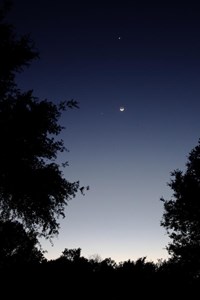 |
VENUS, JUPITER AND MOON IN WESTERN SKY
Venus, Jupiter with Earthshine on Moon. Venus helps make this a pretty sight with Moon lit with earthshine and Jupiter appearing to Moon's left in this evening view of the western sky after sunset on 2012 March 26, 8:16 p.m. EDT (00:16 UT). Picture below taken 53m under darker skies and enlarged shows grouping with Pleiades star cluster. Location: Gainesville, Florida. Photo Details: Canon DSLR EOS 5D II, fixed mount. Canon 28-135mm, f/3.5-5.6 IS USM Lens at 50mm, Exp. 4s @ f/8 (ISO Equiv. 1000).
|
|
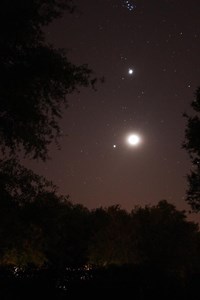 |
PLEIADES CLUSTER WITH MOON, VENUS AND JUPITER
Venus, Jupiter and Moon Appear with Pleiades Star Cluster. Venus appears above Moon (overexposed), Jupiter to left with Pleiades Cluster near top in the western sky after sunset.
Photo Details: Photo taken 2012 March 26, 9:09 p.m. EDT (01:09 UT). Next picture taken one day later. Canon DSLR EOS 5D II, fixed mount. Canon 28-135mm, f/3.5-5.6 IS USM Lens at 50mm, Exp. 20s @ f/4.5 (ISO Equiv. 4000). Location: Gainesville, Florida.
|
|
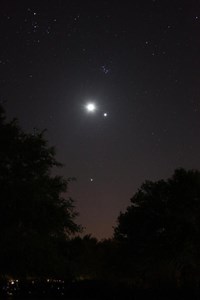 |
ONE DAY LATER: PLEIADES/HYADES CLUSTERS, MOON AND PLANETS
Venus, Jupiter and Moon Appear with Pleiades and Hyades Star Clusters One Day After Previous Picture. Venus appears to right of Moon (overexposed), Jupiter below Moon, Pleiades Star Cluster above and Hyades Star Cluster ("V" Shape)upper left including Aldebaran in the evening western sky after sunset.
Photo Details: 2012 March 27, 01:08 UT. Canon DSLR EOS 5D II, fixed mount. Canon 28-135mm, f/3.5-5.6 IS USM Lens at 41mm, Exp. 10s @ f/4.5 (ISO Equiv. 4000). Location: Gainesville, Florida.
|
|
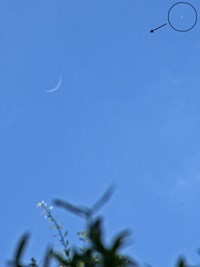 |
VENUS IN DAYLIGHT
Venus seen in Daylight Sky! Can you see Venus during the daytime? Yes you can! Here is a 4.3 day old crescent moon and Venus nearly 3 hours before sunset (2.1 degrees apart) and about 12 degrees from overhead on 2012 March 26 at 5:07 p.m. EDT. Inset shows enlarged area around Venus. Location: Gainesville, Florida. Photo Details: Camera Canon EOS 5D II, Lens Canon EF 35-135mm, f/3.5-5.6 IS USM at 135 mm. (Photo trimmed from original.) Exposure 1/60 sec, f/13 at ISO Equiv. 100.
|
|
 |
THROUGH THE GAINESVILLE CANOPY
Venus and Jupiter Shine Through Gainesville Treetops. Gainesville, Florida, sometimes called a "tree city," can sometimes make it difficult to view the sky. Here, Venus (lf.) and Jupiter (rt.) peak through the Gainesville canopy on 2004 November 5 from backyard of a home 1.5 mi. N.W. of the University of Florida Ben Hill Griffin Stadium. Photo Details: Camera: Canon PowerShot S300 with 13.6 mm, f/5.4-16.2 lens at 13.6 mm. Exposure 1 sec, f/4.5 (ISO unrecorded). Location: N.W. Gainesville, Florida.
|
|
 |
VENUS IN THE PLEIADES - 2012
Venus in the Pleiades Star Cluster. The evening western sky after Sunset on 2012 April 2, 9:51 p.m. EDT (01:51 UT) revealed this most brilliant planet had moved into the region of the well-known Pleiades Star Cluster.
Lens Canon EF 75-300mm, f/4.5-5.6 IS USM at 275 mm. Fixed Mount. Exposure 2.5 sec, f/5.6 at ISO Equiv. 6400. Location: Gainesville, Florida.
|
|
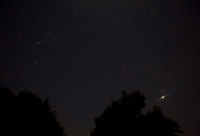
Click picture to enlarge
See labeled version here |
VENUS MEETS THE PLEIADES AGAIN - 2020
Venus Approaches the Pleiades Star Cluster Again. Eight years after Venus met the Pleiades in 2012 April (above), Venus again approached this star cluster. Here is the evening western sky after Sunset, 2020 April 2 at 8:58 p.m. EDT (00:58 UT). Camera Canon EOS 5D II. iOptron Sky Tracker Mount. Location: Gainesville, Florida.
Main Picture: Lens Canon EF 20-35mm, f/5.5-4.5 IS USM at 35 mm. Exposure 305 sec, f/5.6, ISO 1600.
Inset Picture: Lens Canon EF 75-300mm, f/4.5-5.6 IS USM at 1355 mm (cropped). Exposure 305 sec, f/5.6, ISO 1600.
|
|
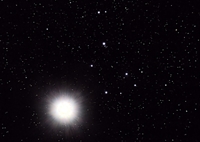
Venus with Pleiades
(Click picture to enlarge)
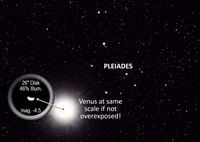
View with Disk of Venus
(Click picture to enlarge)
|
A SUPERNOVA IN THE PLEIADES?
Venus on Edge of Pleiades Star Cluster. No supernova but a picture of Venus approaching edge of the Pleiades! (Details below.)
See Top Picture. Photo made 2020 April 2, with a small 76-mm, f/6.3 refractor at about 9:03 p.m. EDT (April 3, 01:03 UT).
Clouds prevailed on 2020 April 3 when Venus moved into the cluster. But, on the previous day (April 2) Venus was on the edge of the cluster, less than one degree from the cluster's edge. Clear skies gave a beautiful scene giving a magnificent view.
In fact, the brilliant glare of Venus would probably have hidden many Pleiades stars the next day (April 3) when Venus was within the Pleiades.
Binoculars or a small telescope really helped since the glare of Venus and moonlight from a waxing gibbous moon made it difficult to see the normally obvious cluster stars.
The image of Venus in this photo possibly simulates the appearance of a "supernova" but heavily overexposed to show the much fainter cluster stars. Here Venus shines at magnitude -4.5 overpowering even the brightest cluster stars by 900 to 10,000 times.
|
Now See Bottom Photo. Shows actual disk of Venus superimposed on first photo. Taken about 15 minutes later with same 76-mm, f/6.3 telescope. A very short exposure used so not to overexpose disk of Venus (26-arc sec across and 46% illuminated). Notice, even with a small telescope, enlargement of the image of Venus clearly reveals waning crescent disk of the planet if not overexposed!
Venus enters the Pleiades every eight years. Last was 2012 April 3 and the next will be 2028 April 3.
Photo Details
Location: Gainesville, Florida. Date: 2020 April 2
Telescope: TeleVue APO Refractor, 76 mm, f/6.3. Camera: Canon EOS 5D II. Mount: iOptron iEQ30
Top Picture: Exposure: Stack of seven 30 sec exposures, f/6.3, ISO 1600 from 8:57 to 9:06 p.m. EDT
Bottom Picture: Duplicate of above with superimposed image of Venus, 1/8000 sec, f/6.3, ISO 800 at 9:21 p.m. EDT
|
|
 |
NEARLY A HALF VENUS
Venus Nears Last Quarter Phase Taken from an Alachua Astronomy Club star party at its Newberry Star Park. Phase 61%, disk 18", elongation 44 deg. Seeing was very poor making it difficult to achieve good focus. Photo Date: 2015 May 16, 9:15 p.m. (UT May 17, 01:15)). Photo Details: Tele Vue 127 mm, f/5.2 with TeleVue 4x Powermate (effective focal length 2640 mm. Canon DSLR, 5D II. Photo Details: Exp. 1/125 sec, f/21, ISO 1600. Click photo or here for larger image.
|
|
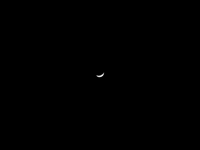
Photo #1. 2020 Apr. 27
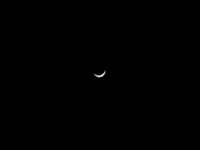
Photo #2. 2020 May 13
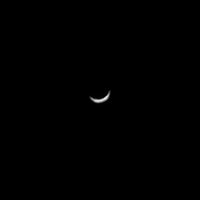
Photo #3. 2020 May 22
|
CRESCENT VENUS
Venus Moves Toward Inferior Conjunction This brilliant planets grows dramatically large when near Earth. So, even small telescopes easily show its large disk as in these three photos taken with only a 90 mm telescope and a 1250 mm focal length.
This telescope, a vintage Meade ETX90-EC Gregory Maksutov-Cassegrain telescope has good optics but a poor mount. The optical section was removed from its mount for these pictures and placed on tripod. Unfortunately, vibration and poor seeing still made focusing very difficult. Nevertheless, in these highly enlarged photos, the waning crescent phase is easily seen. Location: Gainesville, Florida. Click photos for larger images.
Photo Details:
Telescope: Meade ETX90-EC, D = 90 mm, FL = 1250 mm, fixed mount
Camera: Canon EOS 5D II
Photo #1: 2020 April 27, 8:58 p.m. EDT. Alt. 28°, Elong. 40°,
Mag. -4.5, Disk 37", Phase, 28%. Exp. 1/250s, f/13.8, ISO 400.
Photo #2: 2020 May 13, 9:21 p.m. EDT. Alt. 14°, Elong. 28°,
Mag. -4.4, Disk 48", Phase, 13%. Exp. 1/90s, f/13.8, ISO 800.
Photo #3: 2020 May 22, 8:45 p.m. EDT. Alt. 8°, Elong. 18°,
Mag. -4.2, Disk 54", Phase, 5%. Exp. 1/350s, f/13.8, ISO 800
|
|
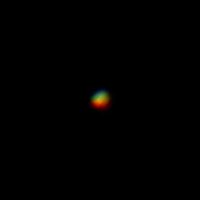
Photo #1. 2020 May 22
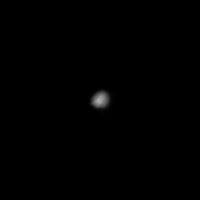
Photo #2. Colors Desaturated
|
RAINBOW MERCURY
Atmospheric Dispersion Colors Mercury Mercury behaves like Venus moving behind the Sun as seen from Earth (superior conjunction) and back between Sun and Earth (inferior conjunction) changing shape as Venus does. The disk of this smaller planet grow and shrinks but never becomes large. Though a bright planet, Mercury remains near the Sun and can be difficult to spot, usually only visible low in twilight skies.
Mercury's low altitude caused its disk to sport "rainbow colors" since Earth's atmosphere dispersed its light due to the low altitude of the planet, only about 9.5 degrees high.
Photo #1 taken with a 90 mm telescope and a 1250 mm focal length, vintage Meade ETX90-EC Gregory Maksutov-Cassegrain telescope that has good optics but a poor mount. The optical section was removed from its mount for these pictures and placed on tripod. Vibration and poor seeing made focusing very difficult. However, the distinct gibbous phase of this planet (67% illuminated) is better revealed in Photo #2 with colors desaturated. Location: Gainesville, Florida. Click photos for larger images.
Telescope: Meade ETX90-EC, D = 90 mm, FL = 1250 mm, fixed mount
Camera: Canon EOS 5D II
Photo #1: 2020 May 22, 9:01 p.m. EDT. Alt. 9.5°, ISO 800.
Photo #2: Same but colors desaturated.
|
|

Here Venus was imaged on 2017 March 18 at 7:59 p.m. EDT when Venus was just 6 degrees high and showed a 58 arc second disk (mag. -4.2, phase 2.6%).
In this composite photo of Venus and a full moon, a cropped image of Venus has been placed next to a typical full moon (taken on a different date) in order to compare their relative apparent sizes. Notice the angular size of Venus is similar to the diameter of Tycho (bright "bull's eye" on lower left side of Moon). Click to enlarge photo.
|
MAJESTIC CRESCENT VENUS
Venus's Large Disk Near Inferior Conjunction.
Since Venus orbits the Sun inside Earth's orbit, Venus periodically passes between Sun and Earth about every 584 days. Near this time Venus appears in telescopes as an extremely large, but with an almost negligible crescent shape with an angular diameter of 60 arc seconds or more (one arc minute)!
(Compare this with Jupiter's disk at its close approach to Earth when the Jovian equatorial angular diameter is large but only about 45 arc seconds.)
Photo Details for Venus: Canon DSLR, 5D II; Canon 100-400 mm, f/4.5-5.6, Ultrasonic IS at 400 mm with Canon 1.4x multiplier (effective focal length 560 mm). Exp. 1/350 sec, f/8, ISO 1600. Click photo or here for larger image.
(The crescent was also easily discerned in binoculars.)
Also see (below) for a (YouTube) video, How Big Am I?, about the changing apparent sizes of the planets.
|
|
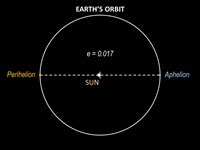 |
PLANETARY ORBIT ANIMATION
Earth and Pluto Orbits Compared Planetary orbits have nearly all small eccentricities and look nearly circular when drawn. Even Pluto's orbit (e = 0.25) appears nearly circular. However, the Sun is displaced one-quarter of the way out from the orbit's center. Animation compares Earth's orbit with Pluto's Orbit. Click picture for larger animation. For still images of each frame, click the following: Earth's Orbit and Pluto's Orbit.
|
|
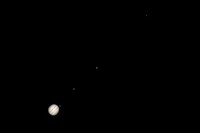 |
JUPITER WITH SATELLITES
Jupiter with its Four Galilean Satellites Even a small telescope can reveal Jupiter's four large Galilean satellites. Cloud bands may even show. If lucky, the Great Red Spot may also face Earth. This photo (taken under very poor seeing conditions) with only a 5-inch telescope still reveals all these features. Europa's shadow also falls on the planet's disk. Photo is a composite of longer exposure to reveal satellites and a shorter exposure for the Jupiter's disk. Click photo to enlarge and also see labeled version. Location: Gainesville, Florida. Photo Date: 2014 Feb. 10, UT 01:45 (disk), 01:26 (satellites). Photo Details: Tele Vue 127 mm, f/5.2 with Tele Vue 4x Powermate (effective focal length 2640 mm. Canon DSLR, 5D II. Exposures 1/250, ISO 2500 (disk), 1/6 sec, ISO 1000 (satellites). Click image for both a larger and a labeled version.
|
|
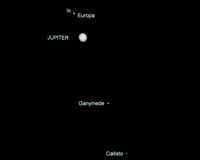 |
JUPITER AGAIN WITH SATELLITES
Jupiter with its Four Galilean Satellites Taken from grounds of the Rosemary Hill Observatory, Bronson, Florida during an Alachua Astronomy Club star party. Photo is a composite of longer exposure to reveal satellites and a shorter exposure for Jupiter's disk. For details and larger images click photo or here (This Jupiter picture is on the RHO Picture Pages.) Photo Date: 2015 Feb. 21.
|
|
 |
SATURN WITH SATELLITES
Saturn with Seven Satellites Taken from an Alachua Astronomy Club star party at its Newberry Star Park. Photo a composite of longer exposure to reveal satellites and shorter exposure for Saturn's disk. Saturn's image very overexposed to bring out satellites and required a fair amount of processing including removal of noise plus some manipulation in order to combine with image of disk. (A black mask used in processing to suppress glare from overexposed disk.) Some image trailing noticeable. (Scope not well aligned!) Seeing very poor making it difficult to achieve good focus. Photo Date: Disk (equatorial disk 18"): 2015 May 16, 11:28 p.m. EDT (UT May 17, 03:28); Satellites: 2015 May 17,12:01 a.m. EDT (UT 04:01). Photo Details: Tele Vue 127 mm, f/5.2 with Tele Vue 4x Powermate (effective focal length 2640 mm. Canon DSLR, 5D II. Exp. (disk) 1/125 sec, f/21, ISO 6400; Exp. (satellites) 4 sec, f/21, ISO 6400.
Photo supports those who could visually count 5 or more satellites at the star party (7 in this photo), a first for some. Mimas was most difficult to spot due to its nearness to Saturn and faintness (abt. mag. +13). Mimas can be barely seen just below slightly brighter Enceladus (abt. mag. + 12). Titan, of course was easily seen (abt. mag +8.5). An 11th mag. star appears to the lower right. (I believe it is TYC 6204-22-1.) Click photo or here for larger image.
|
|
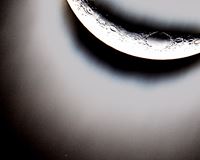 |
URANUS WITH A CRESCENT MOON
Uranus Near a Crescent Moon Taken from grounds of the Rosemary Hill Observatory, Bronson, Florida during an Alachua Astronomy Club star party. For details and larger images click photo or here (This Uranus-Crescent Moon picture is on the RHO Picture Pages.) Photo Date: 2015 Feb. 21.
|
|
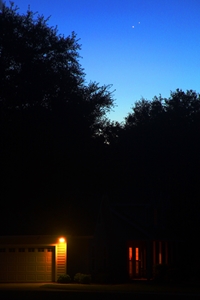 |
VENUS – JUPITER CLOSELY PAIRED
Venus and Jupiter Meet (separation only 0.2 deg) Anyone see the glorious pairing of Venus and Jupiter the morning of 2014 Aug. 18? Except when Mars is occasionally brighter than Jupiter, these two planets are the brightest nighttime sky objects (discounting the Moon). My quick photo does not do the scene justice. Photo taken at 6:25 a.m. EDT when they were 10 degrees above the brightening ENE horizon. Separation was 0.3 degrees (slightly more than a half moon diameter). This was a bit wider than their closest approach (0.2 degrees), but that happened several hours earlier (before they rose). My pinkie easily hid both. Neither planet was at greatest brilliancy but still spectacular: Venus was at magnitude -3.85, Jupiter -1.80. (This made Venus 6.6 times brighter looking than Jupiter.) If you didn't get up to see this, you missed a beautiful sight. The next morning their separation increased to 1-1/4 degrees and they should still make a fine sight for several days. Photo also on spaceweather.com Photo Date: 2014 August 18 6:25 a.m. EDT (10:24:34 UT). Photo Location: Gainesville, Florida. Photo Details: Canon EOS 5D II, Lens 28-135 f/3.5-5.6 IS USM, at 135 mm. Exp. 0.7 sec at f/5.6, ISO 1000.(Photo slightly trimmed from original.)
|
|
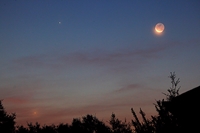 |
CELESTIAL TRIANGLE
Venus, Jupiter & Waning Crescent Moon in a Celestial Triangle Six days after the close meeting between Venus and Jupiter (above), these two bright planets and the waning crescent moon (only 2.2 days before new, 4.3% illuminated) grouped in a beautiful celestial triangle in morning's eastern dawn sky. Click photo for enlarged view or see enlarged labeled version that identifies objects including Praesepe (Beehive) Cluster, and stars in Cancer. Look carefully and one can see Jupiter's satellites and cluster stars. Photo also on spaceweather.com. Photo Date: 2014 Aug. 23 6:21 a.m. EDT (10:21 UT). Photo Location: Gainesville, Florida. Photo Details: Canon DSLR EOS 5D Mark II, Lens Canon 100-400 mm, f/4.5-5.6, Ultrasonic IS with UV Filter at 180 mm, Exp. 4 sec at f/8, ISO equiv. 1600.
|
|
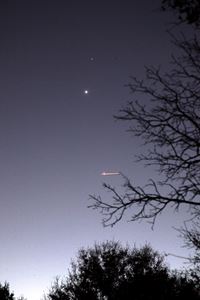 |
VENUS-MARS AND COPTER
Bright Venus & Dimmer Mars Our two closest planets, Venus and Mars appeared only 1-1/2 degrees apart in this southwestern winter sky on Wednesday, 2015 Feb. 18. (A helicopter trail appears below the pair near the tree line.) Over the next several day they would move even closer (0.4 degrees on Saturday). But two days later (Friday), with a separation of 0.7 degrees, a beautiful waxing crescent moon would enter the picture. See Diagram showing this grouping. Then see next picture below showing the actual close grouping of Venus, Mars and the Crescent Moon two days later. Read more about this grouping in the article, Today and the Day After Tomorrow. Click this photo to enlarge. Photo Date: 2015 Feb. 18 7:04 p.m. EST (Feb. 19, 00:04 UT). Photo Location: Gainesville, Florida. Photo Details: Canon DSLR EOS 5D Mark II, Lens 28-135 f/3.5-5.6 IS USM at 135 mm, Exp. 1 sec at f/8, ISO equiv. 2500. Slightly trimmed from original.
|
|
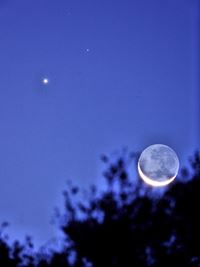 |
VENUS-MARS AND CRESCENT MOON TRIANGLE
Bright Venus, Dimmer Mars & Moon Gather Two days after the above picture was taken (Friday, 2015 February 20) , Venus and Mars appeared only 0.7 degrees apart. Now the waxing crescent moon with earthshine was also only 1.9 degrees from Venus and 1.8 degrees from Mars. Read more about this grouping in the article, Today and the Day After Tomorrow. Mars is now far from Earth (2.2 AU compared with 0.62 AU last spring) and shines at only magnitude +1.3. Venus is also far from Earth (1.4 AU) but being closer to Earth and Sun, and a better reflector, shines at magnitude -3.9 or about 120 times brighter than Mars. (Look closely and you can see a faint star above the planet pair, a 6.3 mag. star in Pisces (HD 6/SAO 128569). Click this photo to enlarge. Photo Date: 2015 Feb. 20 6:58 p.m. EST (23:58 UT). Photo Location: Gainesville, Florida. Photo Details: Tele Vue 76, f/6.3 refractor with Canon DSLR EOS 5D Mark II, Exp. 1 sec at f/6.3, ISO equiv. 800. Slightly trimmed from original.
|
|
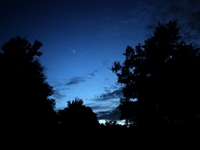 |
VENUS AND JUPITER CONVERGE
Venus and Jupiter Approach These two planets prepare for their close approach two days later. (See following pictures.) Here brilliant Venus (mag. -4.4) and less bright Jupiter (mag. -1.8) appear only 1.2 degrees apart. Photo Date: 2015 June 28, 9:09 p.m. EDT (June 29, 01:09 UT). Photo Location: Gainesville, Florida. Photo Details: Canon DSLR EOS 5D Mark II, Canon 28-135 f/3.5-5.6 IS USM, at 28 mm. Exp. 1/15 sec at f/3.5, ISO equiv. 6400. Slightly trimmed from original.
|
|
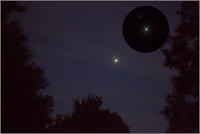 |
VENUS AND JUPITER CLOSER
Venus and Jupiter Near Close Approach These two planets now appear one day before their closest approach. (See following pictures.) Separation is now only 0.66 degrees (40 arc min). Bright star to upper left is Regulus (Alpha Leonis). Enlarge picture and see insert for better view of brilliant Venus (mag. -4.4) shinning about 11 times brighter than Jupiter (mag. -1.8). Photo Date: 2015 June 29, 9:36 p.m. EDT (June 30, 01:36 UT) for full scene. Insert at 9:43 p.m. EDT. Photo Location: Gainesville, Florida. Photo Details: Canon DSLR EOS 5D Mark II, Canon 28-135 f/3.5-5.6 IS USM. Full scene at 75 mm. Exp. 1 sec at f/5.5. Insert at 135 mm. Exp. 1 sec at f/11. Both at ISO equiv. 6400. Sky had scattered clouds and haze. Photos trimmed from original.
|
|
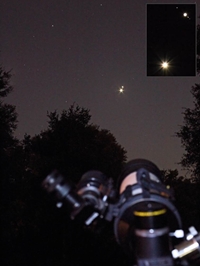
Picture 1
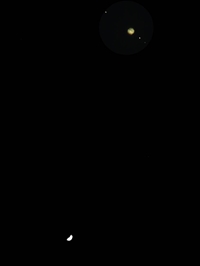
Picture 2

Picture 3
|
VENUS AND JUPITER CLOSEST
Venus and Jupiter Now Finally Together These two planets are now at their closest separation, 0.34 degrees (20.4 arc min), only about 2/3 of a lunar diameter! (40 arc min). Bright star to upper left is Regulus (Alpha Leonis). Enlarge picture and see insert for better view of brilliant Venus (mag. -4.4) shinning about 11 times brighter than Jupiter (mag. -1.8). Insert also shows Jupiter and four satellites. To the right of Jupiter is Io, then Europa, almost blending. At the extreme right is Callisto.
Pictures taken under very difficult conditions including planets low altitude (abt. 20 deg. and less), numerous clouds and very bad seeing. For a detailed description of the evening's adventure to capture these images, see They Came Together.
An even closer appulse occurred 2016 August 27 with a separation of only 0.1 degree! See Venus And Jupiter In An Unusual Close Appulse below.
Location: Gainesville, Florida
Photo Date: 2015 June 30
Camera: DSLR EOS 5D Mark II
Picture 1. Venus and Jupiter. Overall Scene. 9:53 p.m. EDT. Canon 28-135 f/3.5-5.6 IS USM at 135 mm. Exposure 10 sec at f/11, ISO 6400. Insert, 10:05 p.m. EDT. Canon 100-400 mm, f/4.5-5.6, Ultrasonic IS at 400 mm, Exposure 0.3 sec at f/6.7, ISO 6400.
Picture 2. Crescent Venus and Jupiter with Satellites. abt. 9:20 p.m. EDT. Composite of three images. Instrument: Tele Vue 127, f/5.2 with Tele Vue 4x Powermate. Three separate exposures for Venus, Jupiter's disk and its satellites. Images less than ideal due to extremely bad seeing. (Notice jagged edge of crescent Venus, 34 percent illuminated.) To the left of Jupiter is Ganymede, probably optically distorted since the satellite was near the edge of the telescope's field of view.
Picture 3. Jupiter Enlarged from Photo No. 2. The Great Red Spot appears at the seven o'clock position. Io and Europa almost blend (lower right) whereas Ganymede (upper left) suffers from optical distortions. Callisto is at extreme lower right. Turbulent air caused exceptionally bad seeing which blurred images and made good focusing nearly impossible.
|
|

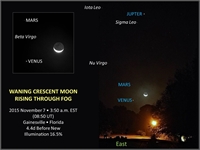
Labeled
|
THREE PLANET–MOON CONVERGENCE
Waning Crescent Moon Among Three Planets During October-November, Venus (mag. -4.3), Jupiter (mag. -1.6) and much dimmer Mars (mag. +1.7) gathered in morning skies. Unfortunately clouds or morning fog often hide the view for North Florida. However, on the morning of 2015 November 7 a waning crescent moon (4.4d before new, 16% illuminated) joined the group as the Moon rose out of low hanging fog that would eventually again hide the scene. Photo Date: 2015 Nov. 7, 3:32 a.m. EST (08:32 UT), Inset 3:50 a.m. EST (08:50 UT). Photo Location: Gainesville, Florida.
Photo Details: Canon DSLR EOS 5D Mark II, Canon 28-135 f/3.5-5.6 IS USM, at 115 mm. Exp. 3 sec at f/5.6, ISO 3200.
Inset: Canon 100-400 mm, f/4.5-5.6, Ultrasonic IS at 400 mm. Exp. 2 sec at f/8, ISO 3200. Images trimmed from original. Also see labeled version.(Time labeled is average of inset and large version.)
|
|
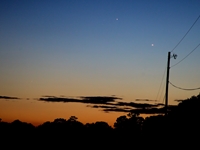
2016 Aug. 25

2016 Aug. 26
|
VENUS, JUPITER AND MERCURY
Venus Rushes to Catch Jupiter While Mercury Watches During late August 2016, Venus (mag. -1.9), having entered the evening sky and raced eastward to catch Jupiter (mag. -1.7). Toward lower left much dimmer Mercury (mag. +0.7 to +0.8) shines through low clouds. (Star just to left of Jupiter is Beta Virginis, mag. +3.6.)These two photos show the advance of Venus over two days.
Venus-Jupiter Separations: Photo One. 3°, Photo Two. 2.5°.
Photo Details: Location: Gainesville, Florida. Canon DSLR EOS 5D Mark II on Fixed Mount. Photo One. Canon EF28-135 mm, f/3.5-5.6 IS USM, at 135 mm. 1 sec at f/5.6, ISO 800 (2016 Aug. 26, 8:40 p.m. EDT). Photo 2: Canon EF100-400 mm, f/4.5-5.6L IS USM at 135 mm. 0.7 sec at f/6.7, ISO 640 (2016 Aug. 26, 8:35 p.m. EDT). Images trimmed from original.
See Photos Below That Display The Real Show: An extraordinary close appulse of Venus and Jupiter on the following day!
|
|

2016 Aug. 27
(Click photo to enlarge)
Labeled Version Here
|
VENUS AND JUPITER IN AN UNUSUAL CLOSE APPULSE
Only One-Tenth Degree Separation! An amazing pairing of Venus and Jupiter occurred Saturday evening, 2016 August 27. On this evening Venus overtook Jupiter as Venus moves eastward on the sky catching Jupiter in a stunning display. Both planets gathered low in the west shortly after sunset — an astronomical appulse. These two brilliant planets appeared only 0.1 degree apart. That's just a fifth of a moon diameter! (Venus and Jupiter will not appear this close until 2065.
Such extremely close gatherings are infrequent. (Some may remember that Venus and Jupiter also had a close appulse during the summer of 2015 on June 30 but their separation was larger, 1/3 degree, or 2/3 of a lunar diameter.)
|
|
On previous evenings the western sky had been mostly clear with more clouds toward the east. But, on this night dark clouds hid most of the western sky with the eastern sky, of course, mostly clear. Fortunately, slight partially clearing occurred for about ten minutes allowing some quick snapshots to record this historic event.
Venus-Jupiter Separation: 0.1° (6'17" or 1/5 Moon Diameter). See labeled version for comparison with Moon.
Venus Altitude & Azimuth: 7.4° and 268°. Magnitudes: -3.9 (Venus); -1.7 (Jupiter).
Date: 2016 August 27, 8:27 p.m. EDT (Aug. 29, 00:27 UT). Location: Gainesville, Florida.
Photo Details: Canon DSLR EOS 5D Mark II on Fixed Mount. Canon EF100-400 mm, f/4.5-5.6L IS USM at 135 mm. Exp. 0.7 sec at f/6.7, ISO 1000 (2016 Aug. 27,). Images trimmed from original.
|
|
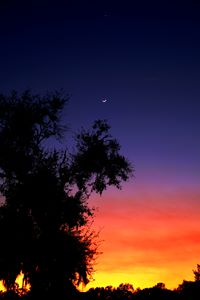
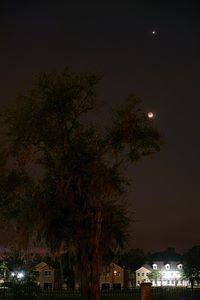
34 Minutes Later
(Click photos to enlarge)
|
MOON AND VENUS IN COLORFUL EVENING TWILIGHT
Moon and Bright Venus with Twilight Colors Low horizon clouds catch sunset colors as waxing crescent Moon and brilliant Venus (mag. -4.5) shine above. Lighting and colors are momentary and change with every minute. Star about one half of a lunar diameter from Moon's upper limb is Phi Aquarii (mag. +4.2).
Date: 2017 January 30, 6:30 p.m. EST (23:30 UT). Location: Gainesville, Florida.
Photo Details: Canon DSLR EOS 5D Mark II on Fixed Mount. Canon 50 mm, f/1.8. Exp. 1/8 sec at f/4.5, ISO 400.
Only 34 minutes later the evening's twilight sky and colors have disappeared. Timing is everything. But earth shine on Moon is obvious.
Date: 2017 January 30, 7:04 p.m. EST (Jan. 31., 00:04 UT). Location: Gainesville, Florida.
Photo Details: Canon DSLR EOS 5D Mark II on Fixed Mount. Canon 50 mm, f/1.8. Exp. 3 sec at f/3.5, ISO 1000.
|
|

(Click photo to enlarge)
|
VENUS AND COLORFULL CLOUDS
Venus Shines Between Colorful Evening Clouds Venus (mag. -3.9) peaks out between colored horizon clouds. A composite of two photos taken several minutes apart were needed to catch Venus when not hidden by the every changing colors of an evening twilight on the day before Thanksgiving 2019. (Below and to right of Venus was Jupiter and a slim (2%) waxing crescent moon but hidden by the clouds.)
Date: 2019 November 27, 5:43 (sky) and 5:51 p.m. (Venus) EST (10:43 & 10:51 UT). Location: Gainesville, Florida.
Photo Details: Canon DSLR EOS 5D Mark II on Fixed Mount with Canon EF 28-135 mm, f/4.5-5.6, IS USM at 135 mm. Exp. 1/500 sec (sky), 1/60 sec (Venus), at f/5.6, ISO 800.
|
|

(Click photo to enlarge)
|
MOON, VENUS AND MARS IN EVENING TWILIGHT
One Day Later Almost exactly one day later than above photo, Moon has advanced westward on sky about 13°. Meanwhile Mars (now far from Earth and shinning only at mag. +1.1 ) is just above Moon. With brilliant Venus (mag. -4.6) to right of Moon, trio make a celestial right triangle. (Venus is now just 17 days before greatest illuminated extent.)
Date: 2017 January 31, 6:40 p.m. EST (23:40 UT). Location: Gainesville, Florida.
Photo Details: Canon DSLR EOS 5D Mark II on Fixed Mount. Canon 50 mm, f/1.8. Exp. 2 sec at f/4.5, ISO 400.
|
|

(Click photo to enlarge)

(Click photo to enlarge)
|
CRESCENT MOON AND VENUS IN EVENING TWILIGHT
Gorgeous Crescent with Earthshine and Bright Venus Where were you the evening of "Tax Day 2018" (April 17)? Hope not finishing taxes but outside facing the colorful, western twilight sky. Here a gorgeous, thin crescent moon adorned with earthshine danced with a neighboring and brilliant Venus. Narrow waxing crescents always seem to help dress up the evening twilight. Add the extraordinary dazzle of Venus, especially when near crescent moons, and twilight becomes even more special. (Lights from airplane appear below and to left of Moon in Top Picture.)
See PDF file for Table (Pg. 1) and Figures (Pg. 2) giving other later 2018 close apparitions of waxing crescent moon and Venus.
Date: 2018 April 17. Location: Gainesville, Florida.
Photo Details: Canon DSLR EOS 5D Mark II on Fixed Mount with Canon EF 28-135 mm, f/4.5-5.6, IS USM at 135 mm.
Top Photo: Time: 8:36 p.m. EDT (UT 00:36, Apr. 18), Exp. 1.5 sec, f/8, ISO 800. Slightly Trimmed from original.
Bottom Photo: Time: 8:53 p.m. EDT (UT 00:53, Apr. 18), Exp. 2 sec, f/5.6, ISO 1600. Trimmed from original.
|
|
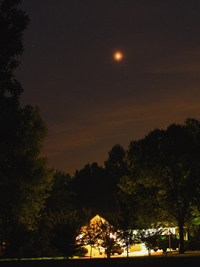
Mars Rises
(Click photo to enlarge)

Mars Nearly South
(Click photo to enlarge)
|
COLORFUL MARS BLAZES IN EVENING SKY
Mars Nears 2018 Favorable Opposition On 2018 July 31 Mars reaches its closest distance to Earth since 2003 with opposition on July 27. Here the orangy color of Mars is enhanced by a global dust storm that began in June. Magnitude Mars = -2.5 (1.3x brighter than Jupiter at mag. -2.2) with Disk Diameter = 23.1 arc sec. Photos taken about 2-1/2 weeks before closest approach (when Magnitude = -2.8 (1.9x brighter than Jupiter at mag. -2.1) with disk = 24.3 arc sec.
Photos taken from a suburban neighborhood showing Mars is easily found and seen with nearby city lights. (Only the Moon and Venus shone brighter.) Unfortunately, from North Florida latitudes (about 30°N), Mars only reaches a maximum altitude of about 36° during this opposition. Unfortunately too, summer in Florida is the rainy season with frequent afternoon and evening storms. Skies often do not clear till well after midnight leaving skies with poor transparency (though sometimes with good seeing). So, these photos were taken under hazy skies with some lingering clouds (especially noticeable in top photo).
Note: Do not mistake the curve of stars to the left of Mars (bottom photo) for the small constellation of Corona Borealis ("Northern Crown"), setting in the west at this time. In fact, these 3rd to 5th magnitude stars belong to Capricornus ("Horned Goat") through which Mars is located. (Limiting magnitude in bottom photo is about 8th magnitude.)
Top Photo Info (Mars Rises in a Suburban Neighborhood)
Date: 2018 July 12. Location: Gainesville, Florida.
Time: 11:24 p.m. EDT (UT 03:24, July 13
Camera: Canon DSLR EOS 5D Mark II on Driven Mount
Lens: Canon EF 50 mm, f1.8
Exposure 10 sec, f/3.5, ISO 1600. (Image slightly trimmed from original
Bottom Photo Info (Mars Nearly South Before Crossing Meridian)
Date: 2018 July 13. Location: Gainesville, Florida.
Time: 2:01 a.m. EDT (UT 06:01, July 13
Camera: Canon DSLR EOS 5D Mark II on Driven Mount
Lens: Canon EF 50 mm, f1.8
Exposure 3 sec, f/2, ISO 6400. (Image slightly trimmed from original)
|
|
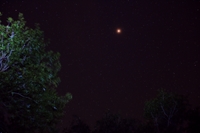
Click for Larger Version
(Opens in New Window)
|
MARS 2020 THROUGH TREES
Mars Shines Through a Canopy of Trees Mars reached its nearest distance to Earth 2020 October 6, closest or brightest until 2035. Here Mars shines beautifully in its yellowish-orange color between a canopy of trees in Gainesville, Florida three days later. Also see next photo.
Date/Time: 2020 Oct. 9 (11:43 p.m. EDT, Oct. 10, 03:43 UT)
Camera: Canon 5D II with 50mm f/1.8 lens; Fixed Mount.
Exposure: 8 sec at f/3.5, ISO 1600.
Processed with Corel PaintShop Pro; Slightly trimmed from original.
|
|
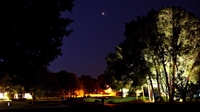
Click for Larger Version
(Opens in New Window)
|
MARS NEAR OPPOSITION 2020
Mars Shines Through a Suburban Street Mars reached its nearest distance to Earth 2020 October 6, closest or brightest until 2035. One week later Mars reaches opposition when opposite Sun on sky. It shines as a brilliant, golden jewel in early eastern skies and is up all night. See photo of Mars easily visible through the lights of a Gainesville, Florida suburban street with the constellation of Pisces.
Date/Time: 2020 Oct. 11 (8:29 p.m. EDT, Oct. 12, 00:29 UT)
Camera: Canon 5D II with 50mm f/1.8 lens; Fixed Mount.
Exposure: 8 sec at f/3.5, ISO 1600.
Processed with Corel PaintShop Pro; Slightly trimmed from original.
|
|

Click for YouTube Video
Runs 13 min. — Has Sound Track
(Opens in New Window)
|
HOW BIG AM I?
"How Big Am I: The Apparent Sizes of Mars and the Other Planets" Some planets, as Mars, change their apparent sizes dramatically. The 2018 close approach is specially significant since Mars has not been this close since 2003 (and will not be this close again until 2035).
See this YouTube Video "How Big Am I: The Apparent Sizes of Mars and the Other Planets."
Planets change their distances from Earth. This video illustrates the corresponding changes in their apparent diameters of planets with emphasis on Mars & the 2018 opposition.
Also see photo on this page ("Majestic Crescent Venus") that illustrates the apparent diameter of a Full Moon to crescent Venus when this planet is near Earth and a large crescent.
|
|
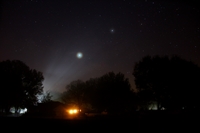
(Click photo to enlarge)
|
VENUS IN A MORNING SKY
Planets Shine Through Light Morning Mist. Venus attended by Jupiter (above right) and Saturn (below left) shine through light morning mist and lights.
Date: 2019 February 6, 6:04 a.m. EST (11:04 UT).
Location: S.W. Gainesville, Florida
Photo Details: Canon DSLR EOS 5D Mark II on Fixed Mount with Canon EF 28-135 mm, f/4.5-5.6, IS USM at 28 mm
Exp. 30 sec at f/4.5, ISO 1600.
|
|
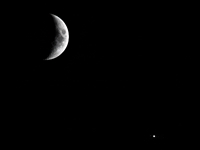
Click to Enlarge
(Opens in New Window)
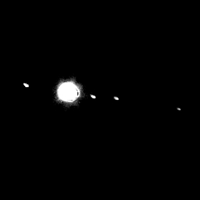
Enlargement of Jupiter & Satellites
(Opens in New Window)
|
MOON AND JUPITER TOGETHER
Close Pass of Moon and Jupiter. It's not often to see magnified views of the Moon and Jupiter in one frame. But on the evening of 2019 October 3 this happened. A five-day-old waxing crescent moon came within about three moon diameters of each object's center as seen from Gainesville, Florida making an attractive pair. (Limb to limb separation about 2.6 moon diameters or 1.4 degrees; center to center 3.1 moon diameters or 1.6 degrees.)
Photo shows a 33% illuminated lunar disk above and to left of Jupiter's 35 arc sec wide disk (about 2% of the lunar diameter). Two exposures, one for Moon and one for Jupiter (mag. -2.0) were combined to show both the Moon and Jupiter's fainter Galilean satellites. From left to right: Ganymede, then Jupiter, next Io, Europa and finally Callisto.
See bottom photo showing enlargement from top photo. (Slight trailing since photo used a fixed mount.)
Camera and Lens: Canon EOS 5D II with Canon Lens 100-400 mm f/4.5-5.6 at 400 mm and a Canon 1.4x Extender for an effective focal length of 560 mm. Fixed mount.
Exposures: f/13 using ISO 400. Moon 1/90 sec at 7:42:19 pm EDT (23:42:19 UT), Jupiter 0.7 sec at 7:43:31 pm EDT (23:43:31 UT).
Processing with Corel Paint Shop. Image slightly cropped.
|
|

Click to Enlarge
(Opens in New Window)
|
MOON AND SATURN TOGETHER
Close Pass of Moon and Saturn. Two days after Moon-Jupiter gathering (see above), the Moon and Saturn came together. A seven-day-old waxing crescent moon came within about three moon diameters of each object's center as seen from Gainesville, Florida making an attractive pair. (Limb to limb separation about 3.5 moon diameters or 1.75 degrees; center to center 4.0 moon diameters or 2.0 degrees.)
Photo shows a 53% illuminated lunar disk above and to left of Saturn's 17 arc sec wide disk (about 0.9% of the lunar diameter) and rings (38 arc sec wide or 2.1% of the lunar diameter). Two exposures, one for Moon and one for Saturn (mag. +0.5) were combined to show both the Moon and Saturn with rings.
Instrument and Camera: Tele Vue 76, f/6.3 with Tele Vue 2x Powermate for 960 mmm effective focal length. Canon EOS 5D II.
Exposures: f/13 using ISO 800. Moon 1/125 sec at 8:18:24 pm EDT (24:18:24 UT), Saturn 1/15 sec at 7:34:25 pm EDT (23:34:25 UT).
Processing with Corel Paint Shop. Image slightly cropped.
|
|
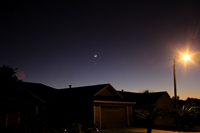
Moon & Three Planets
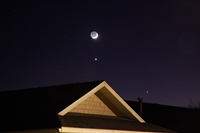
Moon & Two Planets
Click to Enlarge
(Opens in New Window)
|
SPECTACULAR MOON, VENUS, JUPITER & SATURN GATHERING
A Crescent Moon and Three Planets on Thanksgiving Evening. Three naked eye planets gathered in the evening western sky with a thin Waxing Crescent Moon during Thanksgiving evening 2019 November 28.
Top Photo: Shows a 2.3 day old, 5.4% illuminated lunar disk with Venus (mag. -3.9) below Moon, Jupiter (mag. -1.9) below and to right of Venus and Saturn (mag. +0.4) near top of photo and to left of Moon.
Bottom Photo: Shows the Moon with Venus 1.9 degrees below, Jupiter to right and just above roof line. Lambda Sgr (mag. +2.8) is to right of Moon, Phi Sgr (mag. +3.1) in left corner, Mu Sgr (mag. +3.8-3.9) to right of Moon, Delta Sgr (mag. +2.7) just touches roof line on left. Saturn is to upper left but out of field of view.
Location: Northwest Gainesville, FL
Photo Details: Canon DSLR EOS 5D Mark II on Fixed Mount with Canon EF 28-135 mm, f/4.5-5.6, IS USM
Top Photo: Time: 6:01:27 p.m. EST, FL = 47 mm, Exp. 1/8 sec, f/8, ISO 1000.
Bottom Photo: Time: 6:27:39 p.m. EDT, FL = 135 mm, Exp. 3 sec, f/13, ISO 2500.
Images slightly cropped. Processing with Corel Paint Shop.
|
|
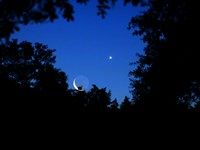
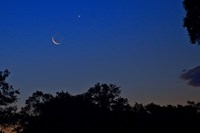
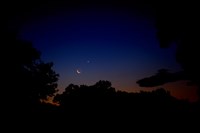
Click Pictures to Enlarge
|
SPECTACULAR MOONRISE WITH VENUS
A Thin Crescent Moon Rises with Venus in Morning Sky. Only 1-1/3 degrees separated this 27.7 day old waning crescent, 1.9 days before new (3.7% illuminated), and Venus (disk 51", 8% illuminated, mag. -4.3). Here they rose from behind trees (Moon only about 5-1/2 to 7-1/2 degrees high) in morning twilight shortly before 6 o'clock a.m. EDT, about 40 minutes before sunrise (6:30 a.m. EDT).
Top Photo: Shows a 2.3 day old, 5.4% illuminated lunar disk with Venus (mag. -3.9) below Moon, Jupiter (mag. -1.9) below and to right of Venus and Saturn (mag. +0.4) near top of photo and to left of Moon.
Bottom Photo: Shows the Moon with Venus 1.9 degrees below, Jupiter to right and just above roof line. Lambda Sgr (mag. +2.8) is to right of Moon, Phi Sgr (mag. +3.1) in left corner, Mu Sgr (mag. +3.8-3.9) to right of Moon, Delta Sgr (mag. +2.7) just touches roof line on left. Saturn is to upper left but out of field of view.
Photo Details:
Location/Date: Southwest Gainesville Location, FL, Date: 2020 June 6
Camera: Canon DSLR EOS 5D Mark II,
Lens:Canon EF 28-135 mm, f/4.5-5.6, IS USM
Mount: Fixed Tripod
Exposures: All at f/5.6, ISO 800.
Top Photo: Time: 5:43 a.m. EST, FL = 135 mm, Exp. 1/2 sec.
Middle Photo: Time: 5:53 a.m. EDT, FL = 115 mm, Exp. 1/6 sec.
Bottom Photo: Time: 5:51 a.m. EDT, FL = 90 mm, Exp. 1/6 sec.
Images slightly cropped. Processing with Corel Paint Shop.
|
|
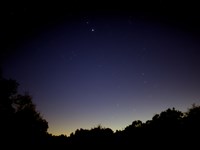
Click Picture to Enlarge
|
JUPITER AND SATURN CONVERGING
Giant Planets on Way to The Great Conjunction of 2020. Jupiter (mag. +-2.0) shines 11x brighter than Saturn above (mag. +0.6). This is how these two planets looked from Gainesville, Florida, about 23 degrees over the southwest horizon Monday evening, 2020 December 7. Jupiter is below and to the right of Saturn, only 1.5 degrees away. Photo taken 6:27 p.m. EST (about one hour after sunset, near end of nautical twilight). One can easily see them together in binoculars. They will finally almost merge (1/5 of a Moon diameter) in just fourteen days (Solstice Day, December 21). This close conjunction will not again be matched until 2080. Three stars in the "handle" of the "Teapot" in Sagittarius appears above the tree line (lower right of center). Synopsis video of The Great Conjunction on YouTube at https://youtu.be/4jbgkJzQYWA.
Photo Details:
Location/Date: Southwest Gainesville Location, FL, 2020 Dec. 7
Camera: Canon DSLR EOS 5D Mark II,
Lens:Canon EF 28-135 mm, f/4.5-5.6, IS USM at ~50mm
Mount: Fixed Tripod
Exposure: f/5.6, 10 sec, ISO 1250.
|
|
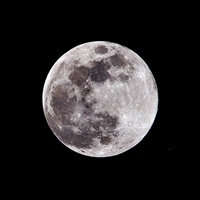
Click Picture to Enlarge
Mars is small dot at lower right.
(7' from Lunar Limb)
A line from Moon's center through
the rayed crater Tycho points almost to Mars!
|
MARS-MOON CONJUNCTION
Full Moon Gathers With Brilliant Mars in Taurus. In late 2022 a Full Moon occulted brilliant Mars for observers for most of North American but not the S.E. USA including Florida. However, the Moon's limb approached within 7 arcmin of Mars as seen here (small orangy dot about at 4 o'clock position from Moon). Mars, in fact, was at opposition (Dec.8 at 1:00 a.m. EST) shinning brilliantly at mag. -1.9 with a 17 arcsec disk while the a 14.2 day Full Moon (99.9%) was at mag.-12.7 or 21,000 times brighter and a disk more than 100 times larger. Moon was nearly due east at altitude 65 deg.
Photo Details:
Date: 2022 December 7
Time: 10:30 EST (Dec. 8, 3:30 UT)
Location/Date: Southwest Gainesville Location, FL, 2022 Dec. 7
Camera: Canon DSLR EOS 5D Mark II,
Lens:Canon EF 100-400 mm, f/4.5-5.6, IS USM at 400mm
with Canon 1.4x Extender (Effective FL 560mm)
Mount: Fixed
Exposure: f/5.6, 1/500 sec, ISO 800.
(Image processed and trimmed from original)
|
|
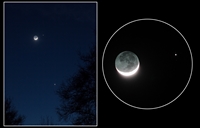
Moon-Jupiter Separation 1°
(Click Picture to Enlarge)
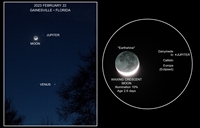
Labeled Version
(Click Picture to Enlarge)
|
MOON-JUPITER-VENUS TRIANGLE
Waxing Crescent Moon Joins Jupiter. Makes a spectacular celestial triangle with Venus during evening twilight. Moon 2.6 days old (10% illumination) shows bright earthshine with Jupiter about one degree away. Jupiter displays three of its four Galilean Moons in a vertical line. Venus lies about 7 degrees below Moon.
Photo Details:
Date: 2023 February 21
Location: Southwest Gainesville Florida
Camera: Canon DSLR EOS 5D Mark II
Lens:Canon EF 100-400 mm, f/4.5-5.6, IS USM at 100mm (wide view) and 400mm (close-up view)
Mount: Fixed
Exposures: (EST is 5 hours behind UT)
Wide View: 1.5 sec, f/8, ISO 1600 at 7:07 p.m. EST.
Close-up: 0.5 sec, f/5.6, ISO 1600 at 7:19 p.m. EST.
(Image processed and trimmed from original)
|
|
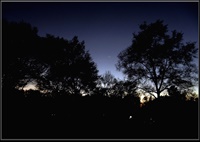
Wide View
Jupiter Upper Left of Venus
(Click Picture to Enlarge)

View with Enlarged Planets
Jupiter Upper Left of Venus
(Click Picture to Enlarge)
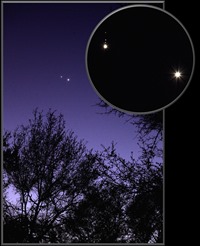
With 100mm & 400mm
Jupiter Satellites (Top to Bottom)
Callisto, Ganymede, Io
(Europa in Eclipse)
|
VENUS-URANUS CLOSE CONJUNCTION
Brilliant Venus Moved to Meet Bright Jupiter. Planet conjunctions often occur but very close pairing between the brightest planets are rare. One such occurrence between Venus and Jupiter happened during their evening twilight appearance on March 1, 2023.
Separation was similar to the apparent diameter of a Full Moon, only about 30 arc minutes (one half degree).
Planet Info:
Venus: mag. -4.0 (phase 86%)
Jupiter: mag. -2.1 (abt. 6x fainter)
Although pictures do not substitute, these photos show conjunction from a North Florida suburban location. Jupiter appears to the upper left of brighter Venus.
Also, a 3-minute video of these photos is here and on YouTube.
Venus and Jupiter will not be this close again from N. Florida until 2032 February 7.
Photo Details:
Date: 2023 March 1
Location: Southwest Gainesville Florida
Wide View
Camera: Nikon Coolpix on Fixed Mount
Exposure: ISO 125, f/3.7, 2.0 sec At 7:01:48 p.m. EST
Processing: ZoomBrowser EX
Narrow Views
Camera: Canon EOS 5D II on Fixed Mount
Lens: Canon 100-400 Mm f/4.5-5.6l IS USM
Exposures: Lens at 100 mm, ISO 1600, f/6.7, 1.5 sec, 7:08:16 p.m. EST
Exposures: Lens at 400 mm, ISO 1600, f/6.7, 0.7 sec, 7:17:50 p.m. EST
Processing: Corel Aftershot 3 & Paintshop Pro 2023 (Cropped)
|
|
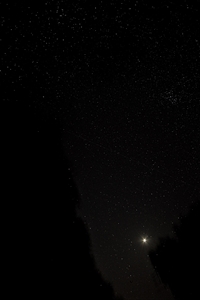
Picture 1
Venus with Uranus & Pleaides
(Click Picture to Enlarge)
See Picture 2: Uranus Labeled
See Picture 3: Detailed Labels
|
VENUS MEETS URANUS BELOW PLEIADES
Brilliant Venus Moved to Meet Faint Uranus with Pleiades Above. Uranus hovers near naked eye visibility and can not only be hard to find but also can be difficult to see without optical aid. But on March 30, 2023 Venus approached within 1°15' from Uranus as seen from Gainesville, Florida during evening twilight. Venus appeared low (altitude 19°) but still remained brilliant shinning between trees. (Astronomical Twilight ended at 9:07 p.m. EDT just before time of photo.)
Though difficult to see with the naked eye, the camera showed Uranus at mag. +5.8 just to the left of bright Venus (mag. -4.0, phase 68%) 8,300 times brighter! A waxing gibbous moon (68% illuminated) shone high above near the zenith (not in picture). Estimated limiting magnitude probably about +10 to +11.
Can you find Uranus in Picture 1 along with the Pleiades Cluster (high above Venus)? Otherwise look at labeled Picture 2 or more detailed labeling in Picture 3.
Photo Details:
Date: 2023 March 30
Location: Southwest Gainesville Florida
Camera: Canon DSL EOS 5D II on iOptron Skytracker Pro (unguided)
Lens: Canon EF 28-135 mm, f/3.5-5.6 at 60 mm
Exposures: Stack of 6, f/8. 60 sec ea., ISO 1600
Times: 9:00:48 to 9:07:07 p.m. EDT (add 4 hrs for UT)
Processing: Sequator & Corel Paintshop Pro
|
|
|